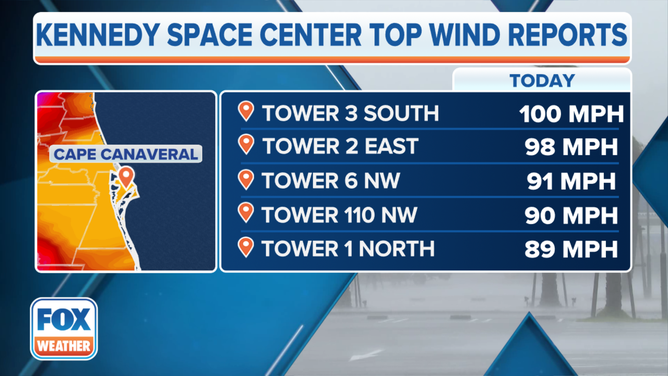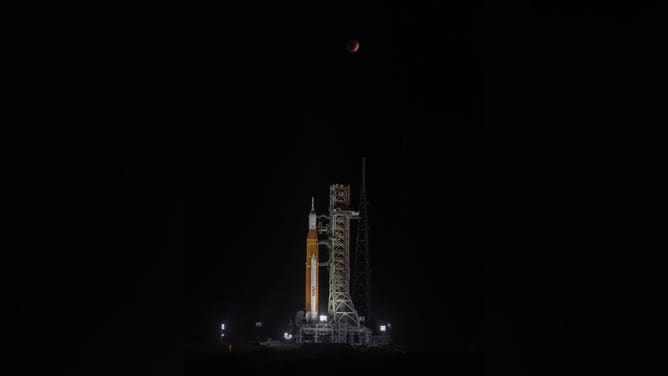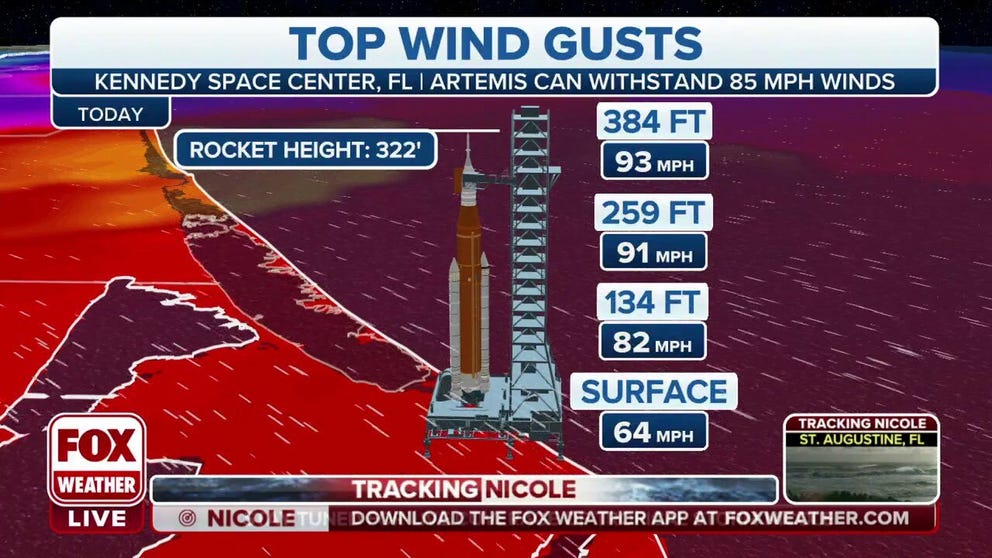Nicole whips 100-mph gust at NASA's moon rocket on Kennedy Space Center launchpad
According to NASA, the Space Launch System rocket can withstand peak winds up to 74.1 knots (85 mph) at 60 feet up. Hurricane Nicole produced a 100-mph wind gust as it made landfall in Florida.
Nicole produces 90-mph wind gusts where Artemis 1 rocket is on launchpad
Even before making landfall, Hurricane Nicole produced nearly 90-mph wind gusts on Florida's Space Coast, where NASA's Space Launch System rocket is on the launchpad awaiting its launch to the moon.
FOX Weather's live coverage of Tropical Storm Nicole continues Thursday as it moves inland across Florida. Follow the FOX Weather Wire for the latest information.
KENNEDY SPACE CENTER, Fla. – Even before making landfall, Hurricane Nicole produced nearly 90-mph wind gusts on Florida's Space Coast, where NASA's Space Launch System rocket is on the launchpad awaiting its launch to the moon.
NASA managers decided earlier this week to leave the 322-foot-tall moon rocket and Orion spacecraft at Kennedy Space Center launchpad 39B, where it has been since the rollout on Nov. 4.
Nicole made landfall as a Category 1 hurricane with 75-mph winds around 3 a.m. near Vero Beach, Florida, about 70 miles south of Kennedy Space Center.
Earlier in the week, NASA said the National Hurricane Center forecast for Nicole was within the margin the SLS rocket is certified to withstand.
WHAT IS NASA'S ARTEMIS 1 MISSION GOING TO DO?
"Current forecasts predict the greatest risks at the pad are high winds that are not expected to exceed the SLS design," NASA wrote in a blog post. "The rocket is designed to withstand heavy rains at the launch pad and the spacecraft hatches have been secured to prevent water intrusion."
According to NASA, the SLS can remain at the launchpad with peak winds up to 74.1 knots (85 mph) at 60 feet up.

Top wind reports at Kennedy Space Center launchpad 39B recorded from Hurricane Nicole.
(FOX Weather)
Around 2 a.m., an 86-mph wind gust was recorded on a lightning tower near the Kennedy Space Center launchpad – exceeding the SLS certification – according to the National Weather Service. After landfall, a 100-mph (87-knot) gust was recorded at launchpad 39B.

A total lunar eclipse glows above NASA's Space Launch System rocket and Orion spacecraft at Kennedy Space Center Pad 39B in the pre-dawn hours on Nov. 8, 2022. (Image: NASA/Sean Cannon
(NASA)
Weather sensors are mounted to the three towers that create the launchpad's lightning protection system. All three sensors recorded wind gusts well above the engineering threshold NASA said SLS is built to withstand.
Hours after Nicole's landfall, the launch towers continued to report sustained winds of around 60 mph.
NASA management says inspections are underway
NASA’s Associate Administrator for Exploration Systems Development Jim Free tweeted a statement on Thursday after Nicole had cleared the Space Coast.
"Teams monitored SLS and Orion remotely during the storm and successfully maintained purges and other essential support," the statement read. "While wind sensors at the launch pad detected peak wind gusts up to 82 miles per hour (71 knots) at the 60-foot level, this is within the rocket’s capability. We anticipate clearing the vehicle for those conditions shortly."
NASA engineers will need to inspect the $4 billion rocket and Orion spacecraft for any damages. Free said images from the pad show "very minor damage such as loose caulk and tears in weather coverings."
A more thorough inspection of the rocket and Orion will be completed soon, Free said.
NASA defended its decision to leave the moon rocket exposed during the storm instead of rolling it back into the hangar.
"We took the decision to keep Orion and SLS at the launch pad very seriously, reviewing the data in front of us and making the best decision possible with high uncertainty in prediction the weather four days out," the statement read. "With the unexpected change to the forecast, returning to the Vehicle Assembly Building was deemed to be too risky in high winds, and the team decided the launch pad was the safest place for the rocket to weather the storm."
NASA moved its next Artemis 1 launch attempt to Nov. 16 to allow more time to assess the rocket and launch facility.
